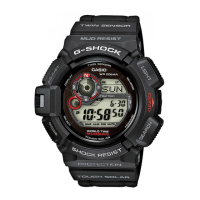
Do you have a question about the Casio 3261 and is the answer not in the manual?
| Model | 3261 |
|---|---|
| Category | Watch |
| Brand | Casio |
| Type | Digital |
| Movement | Quartz |
| Case Material | Resin |
| Dial Color | Black |
| Strap Material | Resin |
| Display | Digital |
| Alarm | Yes |
| Water Resistance | 100 meters |
| Features | Countdown Timer |
| Battery Life | 7 years |
| Backlight | LED backlight |
| Calendar | Auto-calendar (pre-programmed until the year 2099) |
Verify the battery indicator status and take action if power is low.
Configure your Home City and daylight saving time (DST) settings for accurate timekeeping.
Manually adjust the watch's current time and date settings.
Learn how to charge the watch using light and important warnings about heat.
Understand the battery power indicator levels and their corresponding function statuses.
View estimated times required to charge the watch from different levels under various light conditions.
Learn about display and function sleep states when Power Saving is active.
Methods to wake the watch from its sleep state, such as moving to light or pressing buttons.
Procedure to enable or disable the Power Saving function and its indicator.
List of available watch modes and their primary functions.
Instructions on how to switch between different functional modes of the watch.
How to view current time, date, day of the week, and dual time settings.
Procedure to select your primary Home City for accurate time and date settings.
How to toggle the Daylight Saving Time (DST) setting on or off for the selected city.
Steps to manually change the current time, date, year, and 12/24-hour format.
Instructions on how to use the watch's built-in compass to determine direction.
Explanation of direction indicators, angle values, and pointers shown during measurement.
Procedures for magnetic declination correction, bidirectional, and northerly calibration.
How to input magnetic declination for accurate true north readings.
Steps to calibrate the sensor using two opposing directions for accuracy.
How to calibrate the sensor by teaching it the direction of true north.
How to store a specific direction angle in memory for later reference.
Aligning a map with the watch's direction indication to find your current position.
Using the compass and map to determine the direction towards a specific point.
Steps to determine direction angle and follow it using Bearing Memory.
Information on magnetism, location, and environmental factors affecting compass readings.
How to access the thermometer function and return to other modes.
Procedure to calibrate the temperature sensor for accurate readings.
How to choose between Celsius and Fahrenheit for temperature display.
Tips for taking accurate temperature measurements, such as removing the watch.
How to access the mode displaying Moon phase and age information.
Procedure to flip the Moon phase indicator for correct viewing from your location.
How to check the current time in different cities around the world.
How to adjust standard time or daylight saving time for selected World Time cities.
Instructions for starting, stopping, splitting, and measuring two finishes with the stopwatch.
How to set, start, stop, and manage the countdown timer and its alarm.
How to set, test, and turn alarms and the hourly time signal on or off.
How to turn on the display light manually or use the auto light switch.
How to select between 1.5-second and 3-second illumination times.
Important safety notes and usage tips for the auto light switch function.
Explanation of the information displayed in the watch's graphic area depending on the mode.
How to turn the button operation tone on or off and the function of the mute indicator.
Common issues with time settings, sensor malfunctions, and ERR messages.
Solutions for incorrect direction readings, calibration errors, and World Time discrepancies.
Troubleshooting watch not resuming after exposure to light and other charging issues.
Key specifications including accuracy, timekeeping, modes, and sensor capabilities.
Details on bearing sensor precision, temperature sensor, moon data, world time, and stopwatch.
